With an average of 53.4%, India had the highest proportion of domestic and foreign past due B2B invoices of all the Asia Pacific countries surveyed.
With China’s GDP slowing, India has taken over the role of global growth leader with GDP growth expected to reach 7.3% this year and 7.6% in 2018. Due to its relatively closed economy, the country will not feel much impact from China’s slowdown and possible trade measures in the US. Despite this, 38.1% of respondents in India said that they plan to increase protection against potential risks stemming from these developments and Brexit.
Sales on credit terms
The average percentage of transactions on credit in India declined from 45.3% in 2016 to 44.4% this year. The country’s average is also slightly below the average for Asia Pacific overall (45.9%).

- The average percentage of domestic B2B sales on credit made by respondents in India decreased from 51.9% in 2016 to 48.3% in 2017.
- In contrast, the percentage of B2B sales on credit to foreign B2B customers increased slightly from 38.6% in 2016 to 40.4% this year.
- Compared to the regional averages (domestic: 49.5%; foreign: 42.2%), respondents in India are less likely to sell on credit terms to both their domestic and foreign B2B customers.
- Similarly to what was observed in previous surveys, Indian suppliers (like their peers in Asia Pacific) are more averse to selling on credit to their foreign B2B customers than to their domestic B2B customers. This seems to underline Indian suppliers’ perception that foreign B2B transactions may be riskier than domestic B2B transactions.
Overdue B2B invoices (%)
Among the Asia Pacific countries surveyed, India had the highest proportion of domestic and foreign past due B2B invoices. The average percentage of past due B2B invoices in India appears to be flattening out; rising only 0.6 percentage points to 53.4% from 52.8% in 2016.

- On average, 96.7% of respondents in India reported late payments from their domestic B2B customers. This is the highest percentage of respondents reporting late domestic payments in Asia Pacific, well above the regional average of 89.6%.
- In respect to foreign B2B payment delays, these were reported by 90.6% of respondents (regional: 88.8%).
- On average, 56.4% of domestic and 50.3% of foreign B2B invoices went unpaid past the due date. Both these percentages are above the averages reported in Asia Pacific overall (domestic: 44.6%; foreign: 46.1%).
- Similarly to what was observed in 2016, India had the highest average Days Sales Outstanding (DSO) figure in Asia Pacific. This increased to 49 days (from 48 days in 2016) and is much higher than the average DSO of 40 days reported for Asia Pacific overall.
- Looking ahead, only 19.4% of respondents in India do not expect a change in their average DSO over the next 12 months. A high percentage of respondents (23.2%) expect a significant increase in their average DSO over the coming 12 months while 39.8% foresee a minor increase. Both these percentages are much higher than the percentages of respondents who expect a decline.
Payment duration (average days)
India had one of the longest invoice to cash turnaround periods of the Asia Pacific countries surveyed. However, payment duration improved from 66 days in 2016 to 63 days in 2017.
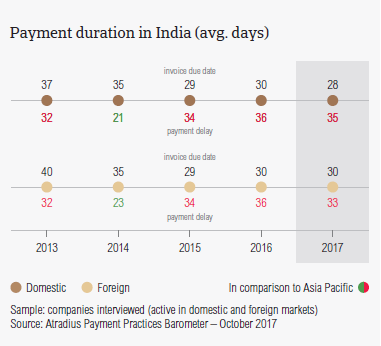
- B2B payment terms on domestic invoices of respondents in India were 28 days in 2017, (two days shorter than one year ago).
- The payment terms given to foreign B2B customers are 30 days on average and did not change compared to one year ago.
- The average payment terms in India are almost in line with those recorded in Asia Pacific overall (domestic: 29 days; foreign: 30 days).
- Domestic B2B customers of suppliers in India seem to delay payments, on average, by 35 days (one day longer than in 2016).
- In 2017, payment delays by foreign B2B customers decreased by three days. More specifically, in 2017, foreign B2B customers of suppliers in India seem to pay faster, delaying their payments by 33 days on average (vs. 36 days in 2016).
- After respondents in Taiwan (on average, 68 days), suppliers in India (63 days) need to wait the longest in the Asia Pacific region to turn B2B receivables into cash. The average payment duration for Asia Pacific is much shorter (55 days).
Key payment delay factors
The main reasons for domestic and foreign payment delays in India are the same as those reported at regional levels. However, Indian suppliers reported this more than their peers in Asia Pacific overall.
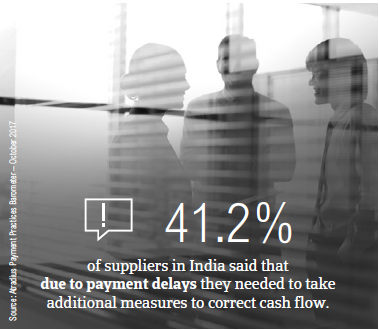
- The main reason for domestic payment delays in India is insufficient availability of funds (cited by 51.5%). This was the highest percentage of respondents stating this key delay factor in Asia Pacific and much higher than the response stated for the region overall (43.8%).
- A second key payment delay factor by domestic B2B customers was buyers using outstanding debts as a form of financings (as stated by 38.6% of respondents). This is different than at regional level, where the second most frequently cited reason for domestic delays was the complexity of the payment procedure (27.4%).
- Foreign payment delays in India seem to occur mainly because of the complexity of the payment procedure (cited by 35.6%) and insufficient availability of funds (32.8%). The same top two reasons for foreign payment delays were reported in Asia Pacific (complexity of the payment procedure: 34.9%; insufficient availability of funds: 33.3%).
- Overdue B2B invoices seem to have impacted most businesses in India; only 14.2% of respondents said that late payments have not impacted their businesses. Of the respondents who reported changes, 41.2% of respondents said that they needed to take specific measures to correct cash flow and 39.7% said that they needed to postpone payments to their own suppliers.
Protection of business profitability
Respondents in India seem some of the most likely in the Asia Pacific region to increase protection against risks stemming from Brexit, US protectionism and the slowdown in Asia.
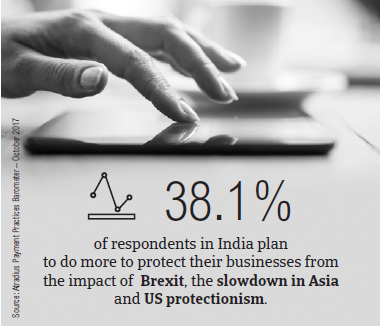
- 38.1% of respondents in India stated that they are likely to increase their use of credit management practices in the face of the above-mentioned developments. This is far above the 30.3% registered in Asia Pacific overall.
- Respondents in India opted for increasing checks on buyers’ creditworthiness (43.6%) and increasing their use of credit insurance (40.8%) as the two practices most likely to be taken to increase protection. In Asia Pacific respondents opted for increasing checks on buyers’ creditworthiness (36.1%) and increasing monitoring of buyers’ credit risk (34.0%).
- The slowdown in China seems to worry Indian suppliers the most. 46.2% of respondents stated that they are likely to increase creditworthiness checks and 45.8% that they will increase their use of credit insurance.
- 44.4% of respondents in India said that to protect against the risks stemming from US protectionism, they are likely to increase creditworthiness checks. 37.2%, second most, are likely to increase their use of credit insurance.
- Suppliers in India seem to be least worried about risks stemming from Brexit. Still, 41.9% of respondents said that they will increase monitoring of their buyers’ credit risk and 40.1% that they will increase creditworthiness checks.
Uncollectable receivables
Similarly to what was reported in 2016, the total value of B2B receivables written off as uncollectable in India is the highest in Asia Pacific.
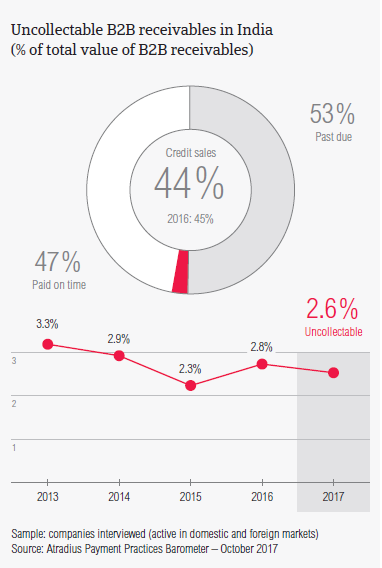
- There was a slight decrease in the total value of B2B receivables written off as uncollectable from 2.8% in 2016 to 2.6% this year. However, India still has the highest percentage of uncollectable receivables in the region, also above the regional average of 2.1%.
- n 2017, domestic receivables were written off as uncollectable more often than foreign receivables (domestic: 1.8%; foreign: 0.8%). Compared to one year ago, the percentage of domestic receivables written off as uncollectable decreased slightly (domestic: 2.0%; foreign: 0.8%)
- Uncollectable receivables in India originated most often from B2B customers in the consumer durables, business services, financial services and machines sectors.
- 45.8% of respondents in India said that the main reason why B2B receivables were written off as uncollectable was the customer going bankrupt or out of business. Other reasons why B2B receivables were uncollectable were the old age of the debt (41.9% of respondents) and the inability to locate the customer (37.9%).
Payment practices by industry
Respondents in India seem to be optimistic about the coming 12 months. Most of the respondents stated that they expect an improvement in the payment behaviour of their B2B customers.
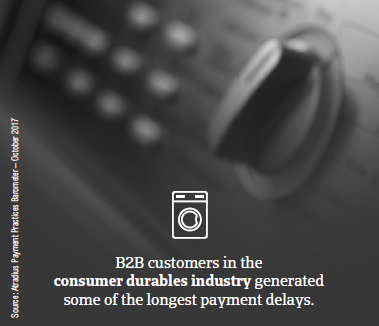
- Suppliers in India gave their B2B customers in the chemicals and metals sectors payment terms much longer than the average reported in the country (29 days). B2B customers in the chemicals sector had, on average, 52 days while B2B customers in the metals sector had 45 days, on average, to fulfil their payment obligations.
- B2B customers in the transport sector were asked to pay their invoices faster and were given on average, 25 days to pay.
- Suppliers in India reported that customers in the electronics and consumer durables sectors generated some of the longest payment delays. B2B customers in these sectors, paid on average 47 and 43 days late respectively.
- Indian suppliers reported that payment delays from B2B customers in the electronics sector occurred mainly because of the complexity of the payment procedure and incorrect information on the invoice (each reason stated by 42.0% of respondents.
- The most frequently reported reasons for payment delays in the consumer durables sector are buyers using outstanding invoices as a form of financing (41.0%) and insufficient availability of funds (38.0%).
関連ドキュメント

3.36MB PDF
